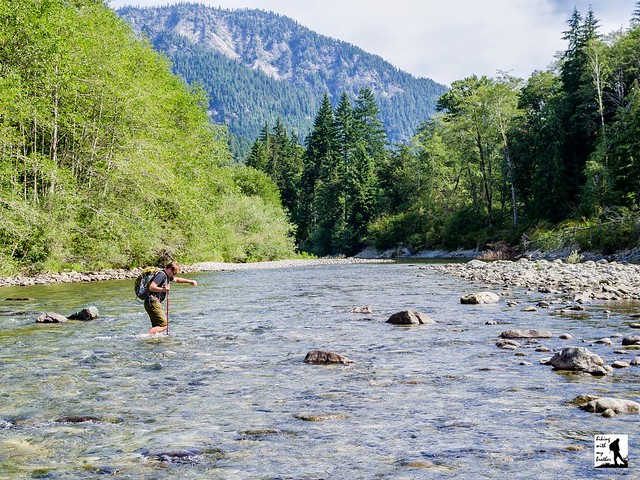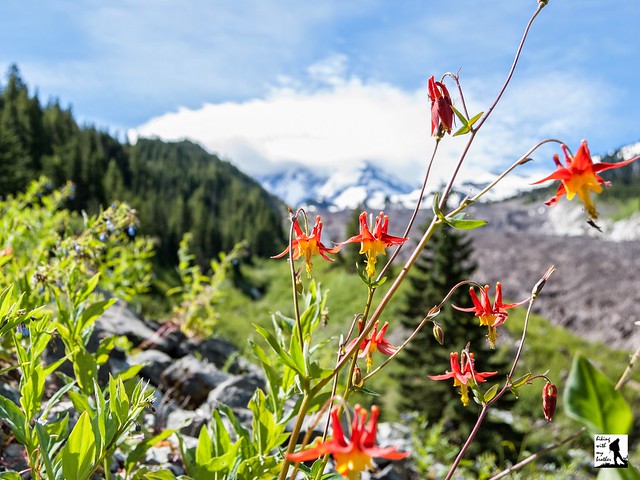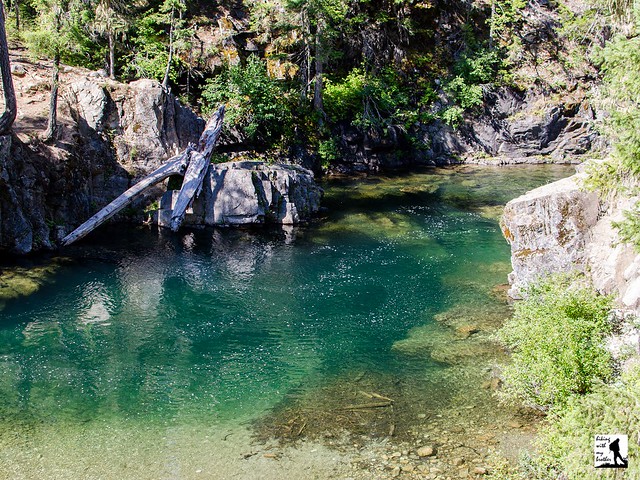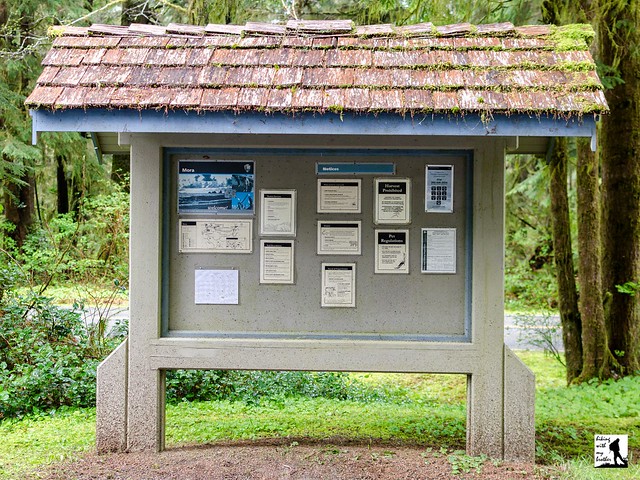Total Ascent: 300ft
Highest Point: 1300ft
Total Distance: 3.6 miles
Location: N 47° 30.818, W 121° 34.197
Required Permit: Discover Pass
Difficulty: Moderate (due to fording river)
 Please note that Middle Fork Road is in the process of being paved. It may be that access to this trail is limited during construction.
Please note that Middle Fork Road is in the process of being paved. It may be that access to this trail is limited during construction.Last summer we headed back out to the Middle Fork Snoqualmie area to find a trail that had been on our list for quite some time. While the Pratt River Trail #1035 has a long history wrapped up in the Middle Fork’s mining and logging past, it was overgrown and abandoned until relatively recently. While most hikers access the trail from the Gateway Bridge, we opted for the more traditional approach of fording the Middle Fork Snoqualmie River at the height of summer.
 Back in 1887, prospectors staked a number of mining claims in the vicinity of Chair Peak. Among them was the namesake of the Pratt River, George A. Pratt, who decided to access his claims via the Pratt River Valley and helped establish the first Pratt River Trail. During this first era, a cabin was built at the confluence of the Pratt and Middle Fork Snoqualmie that became known as the “Halfway House” for its location between North Bend and the Taylor River Ranger Station. The Halfway House provided shelter for those looking to explore the Pratt River Trail, and appeared on USGS maps until the early 1920s, though nothing remains of the cabin today.
Back in 1887, prospectors staked a number of mining claims in the vicinity of Chair Peak. Among them was the namesake of the Pratt River, George A. Pratt, who decided to access his claims via the Pratt River Valley and helped establish the first Pratt River Trail. During this first era, a cabin was built at the confluence of the Pratt and Middle Fork Snoqualmie that became known as the “Halfway House” for its location between North Bend and the Taylor River Ranger Station. The Halfway House provided shelter for those looking to explore the Pratt River Trail, and appeared on USGS maps until the early 1920s, though nothing remains of the cabin today.In 1934 the North Bend Timber Company acquired the rights to log the Pratt River Valley and quickly began constructing a logging railroad largely following the Pratt River Trail route. A bridge across the Middle Fork was completed in 1936 and the railroad stretched the length of the valley by 1937. Over the next several years, the valley walls were logged up to 300 feet on either side of the tracks, which was the furthest reach of the cables. By 1941 the easy timber had been harvested and the North Bend Timber Company began pulling out the rails, leaving the wooden ties behind. Aside from some intermittent truck logging in the 1950s, this was the end of the major logging operations along the Pratt.
 Once the timber interests pulled out the hikers began to return. Some followed the portion of the Pratt River Trail that leads up the Middle Fork toward Goldmyer Hot Springs, while others followed the railroad grade through a recovering forest out toward Melakwa Lake or Talpus Lake. The Forest Service built up the trail, adding boardwalks and small bridges to the sections along the Middle Fork. Eventually the railroad bridge washed out and hikers replaced it in the 1970s with an improvised bridge anchored to stumps on either side of the river. That bridge also washed away, though you can still find the rusting anchoring cables today.
Once the timber interests pulled out the hikers began to return. Some followed the portion of the Pratt River Trail that leads up the Middle Fork toward Goldmyer Hot Springs, while others followed the railroad grade through a recovering forest out toward Melakwa Lake or Talpus Lake. The Forest Service built up the trail, adding boardwalks and small bridges to the sections along the Middle Fork. Eventually the railroad bridge washed out and hikers replaced it in the 1970s with an improvised bridge anchored to stumps on either side of the river. That bridge also washed away, though you can still find the rusting anchoring cables today.Without a bridge, trail use steadily declined and nature began to take back the trail. It wasn’t until 1993 that the Gateway Bridge was built a few miles upstream, once again allowing hikers to access to the trail. Since that time the trail between the bridge and the Pratt River has been rebuilt and renamed the Pratt River Connector Trail. However, much of the trail along the Pratt River is still overgrown and in need of maintenance.
The hike begins from a pullout along FR 56, marked only by a low wall of moss-covered concrete. Cross a small creek and follow the path as it wanders through blackberries and cottonwood toward the sound of the river. Once you reach the river, head upstream for a few hundred yards while looking across the water for a small trail leading up the embankment. Once you locate it, ford the river and follow the trail a short distance up to the Pratt River Connector Trail. Head right along the wide and well-maintained trail for a few tenths of a mile as the trail connects with the old railroad grade and begins its way up the river valley.
Keep an eye out for artifacts as you press deeper into the valley. Rusting metal, old cables and rotting railroad ties can all be found along the way. After about a mile of hiking arrive at a junction simply signed “Big Trees” and “Trail” with arrows directing hikers where to go. If you’re looking for more trail time, head left and continue to follow the railroad grade until you’ve had your fill. On the other hand, if you want a shorter day you can veer right and downhill to find an enormous, 250ft tall Douglas fir tree about third of a mile down the trail.
 There are no big views on this hike, just a hike through a forest that can be as short or long as you would like. Still, the Pratt River Trail is definitely worth a tour, especially for those hikers looking for a bit of adventure. It is possible for experienced hikers to make this a through hike by bushwhacking their way all the way out to the Granite Mountain Trailhead. However, most hikers will be content to trek out to the Big Tree and call it a day, happy to enjoy the quiet solitude of this old trail.
There are no big views on this hike, just a hike through a forest that can be as short or long as you would like. Still, the Pratt River Trail is definitely worth a tour, especially for those hikers looking for a bit of adventure. It is possible for experienced hikers to make this a through hike by bushwhacking their way all the way out to the Granite Mountain Trailhead. However, most hikers will be content to trek out to the Big Tree and call it a day, happy to enjoy the quiet solitude of this old trail. To get there, take I-90 to exit 34 and take a left onto 468th Ave. Follow the road past the truck stop for about a half-mile until you reach SE Middle Fork Road, also known as Forest Road 56. Turn right and follow the road for a few twists and turns, keeping left when the road splits. After 2.2 miles reach SE Dorothy Lake Road. Turn left and continue 6.6 miles to a pullout on the right side of the road marked by some old cement barriers. If you prefer not to ford the river, continue on to the Middle Fork Campground and start the hike from the Gateway Bridge. - Nathan
Print Google Directions >>



















